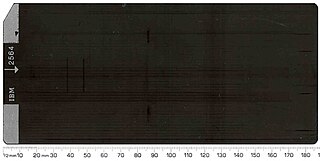 W
WThe IBM 716 line printer was used with IBM 700/7000 series computers in the 1950s and 1960s. It was introduced on May 21, 1952 with the IBM 701 and withdrawn from marketing on July 14, 1969.
 W
WThe IBM 1132 line printer was the normal printer for the IBM 1130 computer system. It printed 120 character lines at 80 lines per minute. The character set consisted of numbers, upper-case letters and some special characters.
 W
WThe IBM 1403 line printer was introduced as part of the IBM 1401 computer in 1959 and had an especially long life in the IBM product line. The original model could print 600 lines of text per minute and could skip blank lines at up to 75 inches per second (190 cm/s), while the model 3 could print at up to 1400 lines per minute. The standard model had 120 print positions. An additional 12 positions were available as an option. A print chain with up to 15 copies of the character set spun horizontally in front of the ribbon and paper. Hammers struck the paper from behind at exactly the right moment to print a character as it went by. In later models, the print chain was replaced by a print train; print slugs instead of being mounted on a chain were placed in a track.
 W
WThe IBM 4610, also known as SureMark, is a thermal point-of-sale printer, originally developed and manufactured by IBM and currently offered by Toshiba Global Commerce Solutions, launched in 1996. It is used by major retailers such as Wal-Mart, Carrefour, Costco, Cencosud, Office Depot, Tesco, Best Buy, Chedraui, King Soopers, London Drugs and Soriana. It had replaced the famous IBM Printer Model 4. With the acquisition of IBM's Retail Store Solutions (RSS) business, the SureMark printers are now produced by Toshiba Global Commerce Solutions.
 W
WA carriage control tape was a loop of punched tape that was used to synchronize rapid vertical page movement in most IBM and many other line printers from unit record days through the 1970s. The tape loop was as long as the length of a single page. A pin wheel moved the tape accurately using holes in the center of the tape. A hole punched in one of the other channels represented a particular position on the page. Channel one was typically used to indicate the top of the page and might be the only channel used. Another channel might indicate the summary line on an invoice, enabling rapid skipping to that line. IBM provides a special manual punch that allowed accurate placement of the channel punches. Skipping occurred under computer control, but a form feed switch on the printer control panel allowed a manual skip to the top of the page. The tapes could be easily changed when new, continuously fed forms were loaded into the printer.
 W
WThe IBM 3800 is a discontinued continuous forms laser printer designed and manufactured by IBM. It is significant as a product because it was both the first laser printer manufactured by IBM, and the first commercially available continuous forms laser printer.
 W
WThe IBM 6640 printer was one of the world's first office ink jet printers. It was originally announced as the 46/40 but later renamed as 6640, as part of the Office System/6 word processing range in 1976.
 W
WThe IBM Printer Model 4 was a dot-matrix point-of-sale printer launched in 1991. It and its successor, the IBM 4610, nowadays, it's really few still in use by retailers. The printer was discontinued in 2005.